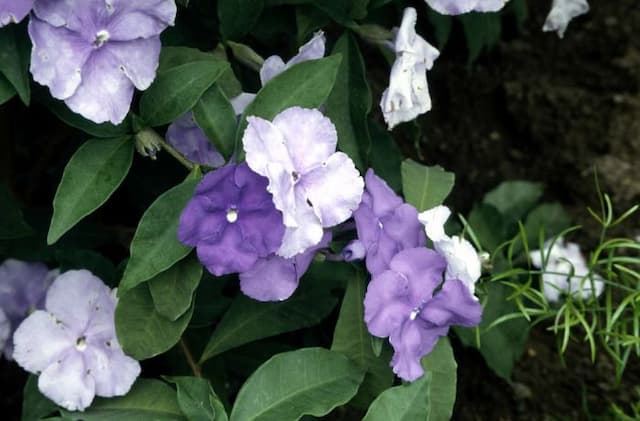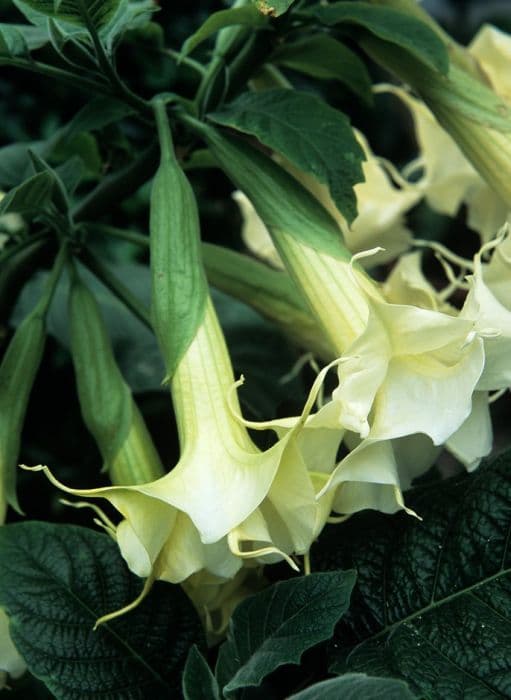Tomato Solanum lycopersicum 'Tumbler'

ABOUT
The 'Tumbler' tomato plant is known for its cascading growth habit, perfect for hanging baskets or containers where it can spill over the edges. The leaves of this plant are typical of tomato plants, being medium green in color and somewhat fuzzy to the touch, with a jagged, tooth-like edge. The foliage forms a lush backdrop for the small, bright red tomatoes that the plant produces. The tomatoes themselves are cherry-sized, perfect for snacking or salads, and are known for their sweet, juicy taste. They appear in clusters, creating a visually appealing and bountiful display against the green foliage. The stems that hold these clusters are strong, despite their delicate appearance, to support the weight of the fruit. Flowers on the 'Tumbler' plant are yellow and star-shaped, indicative of its tomato heritage, which typically precede the formation of the fruit. Even without mentioning its specific dimensions, this plant's trailing nature makes it particularly decorative and suited to spaces where a draping effect is desired.
About this plant
 Names
NamesFamily
Solanaceae
Synonyms
Tumbler Tomato, Cherry Tomato, Tumbling Tom
Common names
Lycopersicon esculentum Mill., Lycopersicon lycopersicum (L.) H. Karst., Solanum lycopersicum var. cerasiforme (Dunal) A.Gray, Lycopersicon pimpinellifolium (Jusl.) Mill.
 Characteristics
CharacteristicsLife cycle
Annuals
Foliage type
Deciduous
Color of leaves
Green
Flower color
Yellow
Height
1 foot (30 cm)
Spread
2 feet (60 cm)
Plant type
Herb
Hardiness zones
9
Native area
South America
Benefits
 General Benefits
General Benefits- Compact Growth: Ideal for small spaces and urban gardens, due to its bushy, compact growth habit.
- Container Friendly: Can be grown in hanging baskets and containers, making it versatile for various garden setups.
- High Yield: Despite its compact size, it produces a plentiful crop of cherry tomatoes.
- Easy to Harvest: Accessible fruiting at arm's reach without the need for staking or supporting.
- Attractive Appearance: Produces vibrant red fruits that can add aesthetic appeal to any garden space.
- Rapid Growth: Reaches maturity and bears fruit quickly compared to larger varieties of tomatoes.
- Disease Resistance: Often bred for resistance to common tomato diseases, leading to a healthier plant.
- Edible Fruit: Produces cherry tomatoes that are edible and can be used in a variety of culinary dishes.
- Pollinator-Friendly: Flowers attract bees and other pollinators, supporting local ecosystems.
- Low Maintenance: Requires relatively minimal care, making it a good choice for beginner gardeners.
 Medical Properties
Medical Properties- Lycopene content: Tomato contains lycopene, an antioxidant that may play a role in reducing the risk of certain types of cancer.
- Vitamin C: Tomatoes are a good source of vitamin C, which is important for immune system function and skin health.
- Potassium: High in potassium, tomatoes can contribute to the maintenance of normal blood pressure and heart health.
- Folate: Contains folate which is important for tissue growth and cell function, and is particularly important during pregnancy.
 Air-purifying Qualities
Air-purifying QualitiesThis plant is not specifically known for air purifying qualities.
 Other Uses
Other Uses- Education: Tomato plants like 'Tumbler' can be used in educational settings such as schools or workshops to teach students about plant biology, growth cycles, and gardening techniques.
- Art supplies: The juice from tomatoes can be used as a natural dye for fabrics, art projects, or as a non-toxic paint for use in children's crafts.
- Insect deterrent: Some gardeners plant tomatoes to repel certain insects that don't like the scent of tomato leaves, aiding in pest management.
- Photography: 'Tumbler' tomatoes, with their abundant, attractive fruit, are often used as subjects for botanical photography and illustration.
- Companion planting: Tomato plants are sometimes used in companion planting strategies to enhance the growth of other plants like basil, improving overall garden health and productivity.
- Reflective mulch: Red plastic mulch is sometimes used with tomato plants to increase fruit production; while not specific to 'Tumbler' tomatoes, they can benefit from this practice.
- Tomato festivals: The 'Tumbler' variety can be showcased in tomato festivals as a unique and prolific type ideal for container growth, offering a point of interest for garden enthusiasts.
- Cooking workshops: Tomato plants like 'Tumbler' can be utilized in cooking classes, where participants can harvest and cook with the fresh tomatoes directly from the garden.
- Stress relief: Tending to a 'Tumbler' tomato plant can be a form of horticultural therapy, which helps people relax and manage stress through the process of caring for plants.
- Biodiversity: Planting diverse varieties of tomatoes, including 'Tumbler,' contributes to the genetic diversity of cultivated plants, which is important for food security and resilience.
Interesting Facts
 Feng Shui
Feng ShuiThe tomato is not used in Feng Shui practice.
 Zodiac Sign Compitability
Zodiac Sign CompitabilityThe tomato is not used in astrology practice.
 Plant Symbolism
Plant Symbolism- Love: The common name of Solanum lycopersicum 'Tumbler' is tomato, and it has been linked historically to themes of love and passion, primarily a result of its association with the "love apple" myth and being considered an aphrodisiac in the past.
- Fertility: Tomatoes are often associated with fertility due to their abundant and colorful fruit, symbolizing growth and the continuation of life.
- Protection: In some folklore, tomatoes are thought to have the power to protect against negative influences, possibly because of their vibrant and lively appearance.
- Good Health: Tomatoes are rich in vitamins and nutrients, and thus they also symbolize good health and vitality.
- Prosperity: The prolific nature of tomato plants when well-cared for can symbolize prosperity and the idea of reaping the rewards of one's efforts.
 Water
WaterTumbler tomatoes should be watered deeply and thoroughly to ensure the roots get enough moisture, which usually means about 1-2 gallons per plant every week, depending on the weather conditions. During hot, dry periods, watering may be needed every other day. It's important to water at the base of the plant to avoid wetting the foliage, which can lead to disease. Reduce watering once the fruit begins to ripen to improve flavor. Always check the soil before watering; it should be moist but not waterlogged.
 Light
LightTumbler tomatoes thrive in full sunlight, which means they should receive at least 6-8 hours of direct sunlight daily. The best spot for these plants is in an area where they are exposed to unfiltered, direct sun for the majority of the day. Avoid placing them in areas that are shaded or partially shaded as this will impact fruit production and quality.
 Temperature
TemperatureTumbler tomatoes prefer temperatures ranging between 55°F and 85°F for optimal growth. Temperatures below 50°F or above 90°F can stress the plant and impede fruit development. For best results, maintain a consistent temperature within this range and protect the plants from extreme heat and frosts, which they can't survive.
 Pruning
PruningPruning tumbler tomatoes is usually not necessary due to their compact, bushy growth habit. However, if the plant becomes too dense, it's beneficial to remove some of the foliage to improve air circulation and reduce disease risk. The best time for this light pruning is in the late morning when the leaves are dry.
 Cleaning
CleaningAs needed
 Soil
SoilThe best soil mix for the Tumbler Tomato should be loose, well-draining with a mix of peat, perlite or vermiculite, and compost. The soil pH for Tumbler Tomatoes should be slightly acidic to neutral, ideally between 6.0 and 7.0.
 Repotting
RepottingTumbler Tomatoes typically do not need repotting as they are annuals; they complete their life cycle in one growing season and are then replanted anew.
 Humidity & Misting
Humidity & MistingTumbler Tomatoes thrive best at moderate humidity levels; aim for 40-70% ambient humidity to support healthy growth without promoting fungal diseases.
 Suitable locations
Suitable locationsIndoor
Place Tumbler Tomato in a sunny spot and use a well-draining pot.
Outdoor
Plant Tumbler Tomato in full sun with stakes or cages for support.
Hardiness zone
3-11 USDA.
 Life cycle
Life cycleThe life of the Solanum lycopersicum 'Tumbler', commonly known as the Tumbler Tomato, begins with seed germination, which occurs in warm, moist soil conditions. Following germination, the seedling develops true leaves and establishes a root system, leading to the vegetative growth phase where the plant increases in size and foliage. The plant then enters the flowering stage, producing yellow blossoms that are pollinated by insects or through manual intervention. After pollination, the flowers develop into green fruit which gradually matures, changing color to the characteristic red as the tomatoes ripen. The ripe tomatoes are harvested, and seeds can be collected from the fruit for future planting. Once the plant has yielded its fruit, it completes its life cycle, which generally occurs within one growing season as Tumbler Tomatoes are typically grown as annuals.
 Propogation
PropogationPropogation time
Spring to Summer
For Solanum lycopersicum 'Tumbler', commonly known as Tumbler Tomato, the most popular method of propagation is by seed. Propagation typically begins 6-8 weeks before the last frost date when seeds are sown indoors to get a head start on the growing season. Sow seeds about 1/4 inch deep in a well-draining seed starting mix. After the seeds have been sown, they should be kept at a temperature of approximately 70-75 degrees Fahrenheit (21-24 degrees Celsius) to ensure optimal germination, which usually occurs within 5-10 days. Once seedlings emerge and grow to have several sets of leaves, they can be transplanted into individual pots and eventually moved outdoors after the danger of frost has passed and they have been properly hardened off.








![Calibrachoa [Callie Mango]](/_next/image?url=https%3A%2F%2Fplants-admin.emdemapps.com%2Fimages%2Fplants%2F%2Fimages%2F604b6514b1579.png&w=640&q=75)
